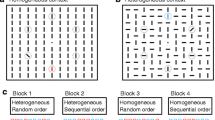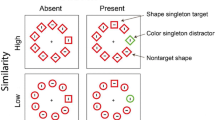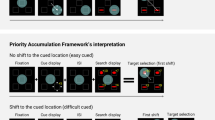Abstract
Two experiments compared reaction times (RTs) in visual search for singleton feature targets defined, variably across trials, in either the color or the orientation dimension. Experiment 1 required observers to simply discern target presence versus absence (simple-detection task); Experiment 2 required them to respond to a detection-irrelevant form attribute of the target (compound-search task). Experiment 1 revealed a marked dimensional intertrial effect of 34 ms for an target defined in a changed versus a repeated dimension, and an intertrial target distance effect, with an 4-ms increase in RTs (per unit of distance) as the separation of the current relative to the preceding target increased. Conversely, in Experiment 2, the dimension change effect was markedly reduced (11 ms), while the intertrial target distance effect was markedly increased (11 ms per unit of distance). The results suggest that dimension change/repetition effects are modulated by the amount of attentional focusing required by the task, with space-based attention altering the integration of dimension-specific feature contrast signals at the level of the overall-saliency map.




Similar content being viewed by others
Notes
The distance effects appear to be dependent mainly on the spatial separation of the current from the preceding target, where larger distances necessarily involve crossing of the vertical and horizontal field meridians. Further analyses of the distance effects in terms whether they occurred within the same field quadrant, crossed the vertical meridian only, the horizontal meridian only, or both meridians revealed meridian crossing costs (which were unaffected by the number of meridians crossed), consistent with prior studies of the reallocation of attention to an (invalid) target following the presentation of a spatial cue at a nontarget location (e.g., Rizzolatti, Riggio, Dascola & Umiltà, 1987; Egly & Homa, 1991). However, it is not clear whether this pattern in the present data reflects a true meridian crossing cost, distinct from a pure distance effect. In an attempt to distinguish between the two types of effect, the data for distance d3 (i.e., the maximum distance possible within a quadrant; for shorter distances, the data available for analysis were insufficient) were examined for meridian crossing effects. This analysis failed to reveal RTs to new targets presented across one or both field meridians relative to the old target to be longer than RTs to targets presented within the same quadrant. While this suggests a pure distance effect, it cannot be really ruled out that meridian crossing plays a role as well, as even with d3 there were too few data available to reliably estimate performance in the respective conditions.
This pattern of effects is very similar to that found by Hommel (1998) in a prime-probe task, that is, dimension, position, and response repetition effects are large when other aspects also repeat; but they are reduced, absent, or even reversed when another aspect changes. As this pattern is evident across perceptual (dimension and position) and response-related aspects of processing, it is possible that these effects also involve some central processing stage (besides perceptual and response-related stages per se)—such as a stage of ‘feature-response binding’ assumed in Hommel’s (1998) ‘event file’ theory.
References
Bundesen, C. (1991). Visual selection of features and objects: Is location special? A reinterpretation of Nissen’s (1985) findings. Perception and Psychophysics, 50, 87–89.
Cave, K. R., & Wolfe, J. M. (1990). Modeling the role of parallel processing in visual search. Cognitive Psychology, 22, 225–271.
Chan, L. K. H., & Hayward, W. G. (2008). Feature integration theory revisited: Dissociating feature detection and attentional guidance in visual search. Journal of Experimental Psychology: Human Perception & Performance (in press).
Cohen, A., & Magen, H. (1999). Intra- and cross-dimensional visual search for single feature targets. Perception and Psychophysics, 61, 291–307.
Egly, R., & Homa, D. (1991). Reallocation of visual attention. Journal of Experimental Psychology: Human Perception and Performance, 17, 142–159.
Eimer, M. (1996). The N2pc component as an indicator of attentional selectivity. Electroencephalography and Clinical Neurophysiology, 99, 225–234.
Folk, C. L., Remington, R. W., & Johnston, I. C. (1992). Involuntary covert orienting is contingent on attentional control settings. Journal of Experimental Psychology: Human Perception and Performance, 18, 1030–1044.
Found, A., & Müller, H. J. (1996). Searching for unknown feature targets on more than one dimension: Investigating a “dimension-weighting” account. Perception and Psychophysics, 58, 88–101.
Geyer, T., & Müller, H. J. (2008a). Distinct, but top–down modulable color and positional priming mechanisms in visual pop-out search. Psychological Research (this issue).
Geyer, T., & Müller, H. J. (2008b). Positional priming of pop-out: A relational-encoding account. Journal of Experimental Psychology: Human Perception & Performance (submitted).
Geyer, T., Müller, H. J., & Krummenacher, J. (2007). Cross-trial priming of element positions in pop-out visual search is dependent on regular stimulus arrangement. Journal of Experimental Psychology: Human Perception and Performance, 33, 788–797.
Hommel, B. (1998). Event files: Evidence for automatic integration of stimulus–response episodes. Visual Cognition, 5, 183–216.
Hopf, J. M., Boelmans, K., Schoenfeld, A. M., Heinze, H. J., & Luck, S. J. (2002). How does attention attenuate target–distractor interference in vision? Evidence from magnetoencephalographic recordings. Cognitive Brain Research, 15, 17–29.
Kingstone, A. (1992). Combining expectancies. Quarterly Journal Experimental Psychology, 44A, 69–104.
Krummenacher, J., Müller, H. J., & Heller, D. (2002a). Visual search for dimensionally redundant pop-out targets: Parallel-coactive processing of dimensions is location-specific. Journal of Experimental Psychology: Human Perception and Performance, 28, 1303–1322.
Krummenacher, J., Müller, H. J., & Heller, D. (2002b). Visual search for dimensionally redundant pop-out targets: Redundancy gains in compound tasks. Visual Cognition, 9, 801–837.
Maljkovic, V., & Nakayama, K. (1996). Priming of popout: II. Role of position. Perception and Psychophysics, 58, 977–991.
Mortier, K., Theeuwes, J., & Starreveld, P. (2005). Response selection modulates visual search within and across dimensions. Journal of Experimental Psychology: Human Perception and Performance, 31, 542–557.
Müller, H. J., Heller, D., & Ziegler, J. (1995). Visual search for singleton feature targets within and across feature dimensions. Perception and Psychophysics, 57, 1–17.
Müller, H. J., & Krummenacher, J. (2006). Locus of dimension weighting: Pre-attentive or post-selective? Visual Cognition, 14, 490–513.
Müller, H. J., Reimann, B., & Krummenacher, J. (2003). Visual search for singleton feature targets across dimensions: Stimulus- and expectancy-driven effects in dimensional weighting. Journal of Experimental Psychology: Human Perception and Performance, 29, 1021–1035.
Nissen, M. J. (1985). Accessing features and objects: Is location special? In M. I. Posner & O. S. M. Marin (Eds.), Attention and Performance XI (pp. 205–219). Hillsdale: Erlbaum.
Pollmann, S., Weidner, R., Müller, H. J., & von Cramon, D. Y. (2000). A fronto-posterior network involved in visual dimension changes. Journal of Cognitive Neuroscience, 12, 480–494.
Pollmann, S., Weidner, R., Müller, H. J., & von Cramon, D. Y. (2006). Neural correlates of visual dimension weighting. Visual Cognition, 14, 877–897.
Rizzolatti, G., Riggio, L., Dascola, I., & Umiltà, C. (1987). Reorienting attention across the horizontal and vertical meridians: Evidence in favor of a premotor theory of attention. Neuropsychologia, 25, 31–40.
Theeuwes, J., Reimann, B., & Mortier, K. (2006). Visual search for featural singletons: No top–down modulation, only bottom-up priming. Visual Cognition, 14, 466–489.
Töllner, T., Gramann, K., Müller, H. J., Kiss, M., & Eimer, M. (2008). Electrophysiological markers of visual dimension changes and response changes. Journal of Experimental Psychology: Human Perception and Performance, 34, 531–542.
Treisman, A. (1988). Features and objects: The fourteenth Bartlett memorial lectures. Quarterly Journal of Experimental Psychology, 40A, 201–237.
Treisman, A., & Gelade, G. (1980). A feature integration theory of attention. Cognitive Psychology, 12, 97–136.
Treisman, A., & Sato, S. (1990). Conjunction search revisited. Journal of Experimental Psychology: Human Perception and Performance, 16, 459–478.
Wolfe, J. M. (1994). Guided search 2.0: A revised model of visual search. Psychonomic Bulletin and Review, 1, 202–238.
Wolfe, J. M., Cave, K. R., & Franzel, S. L. (1989). Guided search: An alternative to the feature integration model for visual search. Journal of Experimental Psychology: Human Perception and Performance, 15, 419–433.
Woodman, G. F., & Luck, S. J. (1999). Electrophysiological measurement of rapid shifts of attention during visual search. Nature, 400, 867–869.
Zehetleitner, M., & Müller, H. J. (2008). A mathematical model of the dimension weighting account. Ludwig Maximilian University Munich (unpublished manuscript).
Acknowledgments
The present study was supported by Swiss National Science Foundation (SNSF) grant PP001-110543/1 (J. Krummenacher) and German National Science Foundation (DFG) grant FOR480 (J. Krummenacher, H. J. Müller, and T. Geyer).
Author information
Authors and Affiliations
Corresponding author
Rights and permissions
About this article
Cite this article
Krummenacher, J., Müller, H.J., Zehetleitner, M. et al. Dimension- and space-based intertrial effects in visual pop-out search: modulation by task demands for focal-attentional processing. Psychological Research 73, 186–197 (2009). https://doi.org/10.1007/s00426-008-0206-y
Received:
Accepted:
Published:
Issue Date:
DOI: https://doi.org/10.1007/s00426-008-0206-y




